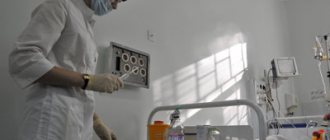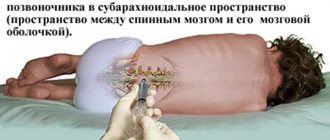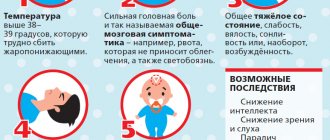Meningitis is characterized by inflammation of the meninges of the spinal cord and brain. The disease is classified as infectious. Meningitis affects adults and children. In children, meningitis often occurs in a fulminant or acute form. Adults are more likely to suffer from meningitis caused by meningococcal infection; women are sick less often than men.
The Yusupov Hospital diagnoses and treats meningitis. In the laboratory you can undergo a number of tests for the causative agent of the disease, and experienced doctors provide consultations in the hospital. Meningitis can have a fulminant course, in which case qualified assistance should be provided immediately. With meningitis, it is very important that the diagnosis be made in the first days of the disease.
Causes of meningitis
Meningitis can be of infectious or non-infectious origin. The infectious form of the disease develops as a result of the penetration of microorganisms into the body: bacteria, viruses, fungi and parasites. Non-infectious meningitis develops in patients as a result of taking certain medications and the formation of tumors.
In medicine, classification is used according to the type of pathogenic microorganisms. It is important for a modern person to know how to recognize meningitis and what types of disease exist:
- bacterial meningitis is most often caused by streptococci, meningococci, pneumococci and Haemophilus influenzae, which are transmitted by airborne droplets;
- viral meningitis. The most common form of the disease. This type is characterized by the least severity. The causative agents of viral meningitis are enteroviruses;
- fungal meningitis develops as a result of the activity of certain types of fungal microorganisms;
- parasitic meningitis.
The list of therapeutic measures for meningitis is determined by the factors that caused the development of the disease. Thus, when treating bacterial meningitis, antibiotics are prescribed, which are ineffective for viral meningitis. If a person knows how to recognize meningitis, then the likelihood of diagnosing the disease at the initial stage and the effectiveness of therapeutic measures are high.
To determine the causes of meningitis, specialists at the Yusupov Hospital use modern diagnostic equipment. An important advantage of examinations at the Yusupov Hospital is that patients do not need to wait in lines, since appointments with specialists can be made in advance.
Expert opinion
Andrey Igorevich Volkov
Neurologist, Candidate of Medical Sciences
For several years in a row, infectious diseases have been among the causes of the development of pathologies of the nervous system. Meningitis accounts for 30-40% of cases. Modern drugs and high-quality diagnostics do not guarantee the absence of death. Mortality is explained by late seeking of medical help. Doctors associate this with the atypical course of meningitis, when the symptoms are not specific for a long time.
It is not possible to determine meningitis on your own. The clinical picture of the disease is varied. Signs differ according to the etiological factor. The initial symptoms of meningitis are often mistaken for cold symptoms. As the infection spreads, the condition worsens sharply. The high risk of death due to meningitis persists for 1-2 days from the onset of the first pathological symptoms. Delayed diagnosis and therapy lead to the development of severe, life-threatening complications. Therefore, it is important to immediately consult a doctor if you suspect the development of meningitis. At the Yusupov Hospital, the examination takes a minimum amount of time. The treatment plan is determined in accordance with the identified pathogen.
Causes and mechanism of development
Meningococcal meningitis is a bacterial infection of the meninges. The causative agents of the infection are Neisseria meningitis (meningococci) of twelve serological groups. They are transmitted from person to person through droplets of secretions from the throat and upper respiratory tract of the bacilli carrier or a sick person. The spread of microorganisms is facilitated by close, prolonged contact:
- Sneezing or coughing towards another person;
- Sharing utensils;
- Kisses;
- Living in close proximity to an infected person.
- According to the course of the disease, the following forms of infectious meningitis are distinguished:
- Fulminant (a detailed clinical picture is formed in less than 24 hours);
- Acute;
- Subacute.
According to the nature of the inflammatory process, purulent and serous meningitis are distinguished.
With primary infectious meningitis, infectious agents penetrate from the external environment directly into the nervous tissue. Secondary meningitis develops when the infectious agent moves from the primary foci of inflammation to the membranes of the brain. Make an appointment
Risk group
Children and the elderly are at risk for meningitis. In addition, this disease is often diagnosed in people with an absent spleen and immunodeficiency.
The spread of meningitis, like all other infectious diseases, is more active in crowded places, closed groups, for example, in kindergartens, schools, student dormitories, barracks, since it is easier to get meningitis if you are in the company of asymptomatic carriers.
Most often, meningitis is transmitted by airborne droplets. This mechanism of infection transmission is considered the most common and characteristic of meningitis of viral origin. The infectious agent is transmitted through coughing, sneezing, kissing and sexual contact.
Newborn babies can become infected from an infected mother through the birth canal. The likelihood of infection is especially high in children born by caesarean section. Bacterial and viral meningitis can be transmitted this way.
Infection with meningitis can occur through the oral-fecal route: through dirty food or untreated water.
In addition, meningitis can develop as a result of the bite of an insect or animal that carries an infectious agent.
Expert opinion
Andrey Igorevich Volkov
Neurologist, Candidate of Medical Sciences
Meningitis of any origin is a dangerous infectious disease that affects adults and children. Without timely treatment, death occurs in 80% of cases. It has been proven that, despite the initiation of therapy, 10% of patients die within the first day from the onset of pathological symptoms. Meningitis most often affects children. Viral etiology accounts for 60–70% of cases. Fungal meningitis accounts for 1–3%. It is not possible to diagnose and treat an infectious disease at home. Therefore, it is necessary to seek medical help soon after the first signs of the disease appear.
The most informative method for diagnosing meningitis is lumbar puncture. The causative agent of the disease is sown in the cerebrospinal fluid. To identify the localization of the pathological focus in the brain area, neurologists at the Yusupov Hospital prescribe MRI and CT. Etiotropic therapy is selected depending on the results obtained. Symptomatic treatment is aimed at alleviating the general condition. Vaccination is considered the only reliable means of preventing meningitis.
a brief description of
As the infection progresses, the disease spreads the inflammatory process throughout the brain and its parts. It is as a result of this process, with this deviation, that the outer lobe of the brain malfunctions, and not the cells themselves. The lesion begins to capture the membranes, where it continues to concentrate in the future. The disease has two stages: primary and secondary. The first option manifests itself in brain disorders, and the second is characterized by the spread of anomaly due to another pathogen.
In children, the disorder develops rapidly and occurs in just a few days. However, an exception in medicine is the tuberculosis form, which is characterized by a longer period of activity. You need to understand that the disease is not directly dependent on a person’s age; it can begin with an unhealthy general state of health. For example, if a baby is born earlier than expected, then as a result of a weak immune system, there is a high risk of meningitis.
Symptoms of meningitis in adults
Meningitis usually has a sudden onset. The first symptoms of meningitis in adults are: fever, headaches, vomiting (the so-called meningeal triad). However, these pathological signs of meningitis also accompany other infectious diseases, so it is important to know the features of the manifestation of meningitis.
Meningitis is characterized by rapid development with pronounced signs of intoxication:
- headache;
- high fever and chills;
- confusion and loss of consciousness;
- convulsions;
- skin rash;
- muscle weakness;
- drowsiness;
- photophobia, increased skin sensitivity, reaction to sound;
- stiff neck;
- loss of appetite, nausea, vomiting;
- conjunctivitis;
- increased heart rate.
In patients with meningitis, the first sign of the disease is often a rash on the skin and mucous membranes. The rash is initially hemorrhagic in nature, sometimes spots and papules appear on the skin. The rash is considered an allergic reaction to medication.
Over the next few hours, hemorrhagic elements of various sizes and shapes appear. They may look like small spots or stars. Elements of the rash may merge and form spots.
Make an appointment
Headache
A severe headache should alert you. Headaches caused by meningitis feel different from other types of pain. Their intensity is much higher than that of headaches associated with dehydration or migraines. Taking over-the-counter pain medications does not provide relief.
Nausea and vomiting
Nausea and vomiting that occur with a headache are not absolute signs of meningitis. These symptoms may accompany other diseases, such as migraine. Close attention should be paid to other conditions that occur along with vomiting and nausea.
Vomiting with meningitis rarely occurs once, most often it is repeated, repeated, and is not associated with food intake.
Heat
An increase in body temperature, like other symptoms, may indicate the development of meningitis. With this disease, the temperature is usually much higher than with acute respiratory infections. In addition, taking antipyretic drugs for meningitis is ineffective - it is very difficult and short-term to reduce the temperature.
Pain in the neck
Quite often, patients with meningitis complain of pain and a feeling of tension in the neck, and it is difficult for them to turn or raise their head. This is due to pressure from the inflamed membranes of the brain. This symptom can also be observed when the neck muscles are strained or injured from a sudden movement of the head.
The suspicion of meningitis can be confirmed by bending the patient's hips in a horizontal position - the occurrence of pain in the neck while performing this movement is a sign of meningitis.
Difficulty concentrating
Inflammation of the meninges during meningitis is associated with perception difficulties in patients. It is difficult for them to read an article to the end, concentrate on a conversation, or complete the task at hand. The degree of confusion may worsen as brain swelling increases. In addition to lethargy and confusion, patients experience a drop in blood pressure, shortness of breath, and noisy shallow breathing.
Lethargy, drowsiness
Patients become unable to act independently, they develop drowsiness and lethargy. This condition occurs as a consequence of general intoxication of the body or cerebral edema. Bacterial meningitis can be accompanied by a sharp depression of consciousness and even coma.
Photophobia
A manifestation of photophobia in patients with meningitis is severe pain that occurs in bright light. The appearance of pain and sensitivity of the eyes, as a reaction to light, is considered an alarming signal, as it is a characteristic sign of meningitis.
Convulsions
Convulsions, sometimes with involuntary urination and disorientation in space, are observed in 20% of patients with meningitis. Their course is similar to epileptic, or the appearance of tremor of individual muscles and individual parts of the body is observed. The occurrence of seizures (generalized and local) is associated with irritation of the cortex and subcortical structures of the brain.
Characteristic rash
A hemorrhagic rash on the skin and mucous membranes is not a specific symptom of meningitis. It appears in 25% of patients with bacterial meningitis and is most often observed in diseases of a meningococcal nature, since it is meningococcus that causes damage to the internal walls of blood vessels. The appearance of skin rashes is usually observed 15-20 hours after the onset of the disease. In this case, the rash is polymorphic - it can be roseolous, papular, in the form of nodules or petechiae. The rashes have an irregular shape and may protrude above the skin level.
Psychomotor agitation, anxiety
Anxiety, agitation and disorientation occur in patients with a form of the disease such as meningoencephalitis at the onset of the disease. With the bacterial form of meningitis, similar symptoms may appear 4-5 days after the onset of the disease. After psychomotor agitation, patients may experience loss of consciousness or coma.
At the beginning of the disease, as well as in later stages, patients with meningitis may develop symptomatic psychosis, manifested by agitation or, conversely, lethargy, delirium, visual and auditory hallucinations.
Delusions and hallucinations can occur in patients with lymphocytic choriomeningitis and meningitis, which is caused by the tick-borne encephalitis virus.
If you have at least one of the above symptoms, you should immediately consult a doctor, since it is impossible to check meningitis yourself. To identify this disease and immediate treatment, qualified medical care is required.
The Neurology Clinic of the Yusupov Hospital offers high-quality diagnostics and treatment of meningitis of any form. The hospital's doctors use an individual approach in their work. Treatment tactics, developed individually for each patient, are explained to him in detail during the consultation process and are implemented as accurately as possible during therapeutic measures.
Expert opinion
Tatyana Aleksandrovna Kosova
Head of the Department of Rehabilitation Medicine, neurologist, reflexologist
Infectious diseases have been among the causes of death among the population for a long time. Meningitis is registered in 30–40% of cases. Unfortunately, despite the quality of the treatment, the possibility of death cannot be ruled out within the first 24 hours after the onset of clinical symptoms of the disease.
Among the etiological factors of meningitis, sinusitis is distinguished. The accumulation of purulent contents in the sinuses without proper treatment can lead to the spread of infection to the meninges. In such cases, meningitis is considered as a complication of sinusitis. The effectiveness of treatment for sinus inflammation depends on the quality of the diagnosis.
The Yusupov Hospital conducts a full range of examinations necessary to detect sinusitis and meningitis. The clinic’s doctors select the correct therapy based on the data obtained and the nature of the pathology. Doctors advise not to delay seeking medical help if symptoms of sinusitis develop and not to self-medicate. Without proper treatment, pus quickly spreads beyond the sinuses and penetrates into the brain area. An examination by a doctor will reduce the risk of a complicated course of the disease.
What's the point of a brain MRI?
The principle of operation of the resonant device is to generate special waves - a magnetic field, which has the ability to interact with hydrogen atoms contained in the human body. As a result of this process, resonance occurs, which is diagnosed by special sensors on the tomograph. All received information is transferred to a computer, where it is converted into visualized images in different planes. You can monitor the progress of the study and study body structures in real time, which greatly facilitates the work of medical staff.
In many Moscow centers, tomography is performed if the patient independently decides to undergo a scan or is prescribed a referral by the treating expert. But, often, if there is a possibility of developing meningitis, it is better to seek help from a professional. It is with a referral from the attending physician that the radiologist will be able to understand exactly which places should be examined in more detail, because the referral will indicate what exactly is worth paying attention to.
Usually, to get a complete picture of what is happening in the body of a person suffering from meningitis, it is necessary to conduct a contrast examination. When using an additional amplifier, almost no one experiences allergic reactions, but it is worth warning the doctor in advance about the presence of contraindications.
Sinusitis and meningitis: the relationship of diseases
Meningitis develops as an independent disease and can be a complication of pathological processes. Sinusitis and meningitis are interrelated, since the accumulation of pus in the maxillary sinuses can cause inflammation of the lining of the brain. It is important for people at risk to know how sinusitis turns into meningitis and what symptoms the patient experiences. The development of sinusitis by contact occurs against the background of an existing infectious process. Infection accumulated in the paranasal sinuses can cause inflammation of the meninges.
The development of complications with sinusitis is rare, since modern specialists use effective treatment methods. However, if treatment is untimely and ineffective against the background of reduced immunity, the patient may develop meningitis. If a patient suspects meningitis or their health has sharply worsened, it is necessary to consult a general practitioner or neurologist, who will prescribe an examination and determine the cause of the problem.
At the Yusupov Hospital, patients are provided with a wide range of medical services, which include examinations, therapeutic measures, disease prevention and recovery after illness. If meningitis is suspected, patients are urgently hospitalized.
The most important and revealing test for suspected inflammatory processes in the membranes of the brain and spinal cord is a lumbar puncture. It is necessary to examine the cerebrospinal fluid to identify the cause of inflammation and prescribe adequate therapy.
The main advantages of brain MRI in the examination of meningitis
Magnetic scanning using a resonant device is not necessary to diagnose an infectious disease. Specialists use this clinical technique to obtain additional information to find out the area of the lesion and determine the likely side effects. When prescribing an MRI of the brain to confirm the conclusion, the main factors indicating the presence of the described deviation are considered:
- Swelling of the gyri.
- Excessive accumulation of cerebrospinal fluid.
- Increased space in the interhemispheric foramen.
To obtain more informative and high-quality photographs, testing is prescribed with the introduction of an additional amplifier in the form of a contrasting component, which is based on iodine. MRI of the brain is optimal for diagnostics in childhood, since during operation the device does not produce toxic X-ray radiation. That is why similar procedures can be performed on a child many times without fear for his health.
Diagnosis of meningitis
The diagnosis of meningitis can be made based on the results of additional studies - laboratory and instrumental:
- detailed blood test;
- fundus examination;
- X-ray examination of the skull;
- heart electrocardiograms;
- electroencephalography;
- computer and magnetic resonance imaging.
Doctors at the Yusupov Hospital confirm or refute the diagnosis of meningitis using a study of cerebrospinal fluid. A lumbar puncture is performed immediately after examining the patient. Normal cerebrospinal fluid is transparent, colorless, and flows out under a pressure of 130-180 mm during puncture. water Art. It detects from two to eight cells in one microliter. In serous meningitis, the cerebrospinal fluid is colorless, clear or opalescent. During cerebrospinal puncture, it flows out under a pressure of 200-300 mm. water Art. at a speed of 60-90 drops per minute. In the cerebrospinal fluid, from 200 to 800 cells are determined in 1 μl, 80-100% are lymphocytes. The amount of protein and glucose is increased. After the puncture, the patients' condition improves significantly.
With serous-bacterial meningitis, the cerebrospinal fluid may be colorless or yellow, opalescent. During puncture, it flows out in a stream under a pressure of 250-500 mm of water column. The number of cells increases to 800-1000 in 1 μl, they contain the same number of lymphocytes and neutrophils. Protein levels are increased and glucose concentrations are significantly decreased.
The liquor in purulent-bacterial meningitis is cloudy, whitish or greenish-brown. Due to the high viscosity and blockage of the liquor pathways, it often flows out in rare drops under high pressure. The number of cells in one milliliter of cerebrospinal fluid exceeds 1000; they consist mainly of neutrophils. Protein concentration varies from 600 to 16,000 mg/l, glucose levels are reduced.
To confirm the diagnosis of meningitis, doctors use bacteriological examination of mucus from the nasopharynx and cerebrospinal fluid. During bacterioscopic examination of cerebrospinal fluid, smears are stained with Gram or methylene blue. To exclude fungal meningitis, the specimen containing cerebrospinal fluid is stained with ink. Laboratory assistants isolate a pure culture on media with the addition of normal horse serum or cattle serum and identify it by biochemical activity and antigenic structure.
In case of viral meningitis, in preparations prepared with Gram staining and ink, it is impossible to identify the causative agent of the infection. Cultivation of bacteria and fungi also gives negative results. By culturing cellular material with standard laboratory cell lines, a pathogen serologically identical to the measles virus can be isolated. Rubella virus is isolated using the co-cultivation method.
To identify oligoclonal immunoglobulins, the method of agarose gel electrophoresis or isoelectric focusing of cerebrospinal fluid gamma globulins is used. Immunoglobulins appear in a number of viral infections. As a result of immunological studies, viral antigens or antibodies are detected in the cerebrospinal fluid, and the nucleic acid of the virus is detected using the polymerase chain reaction method. The enzyme immunoassay method detects pathogen antigens in feces, urine or saliva. Express methods allow you to quickly and early determine the presence of the herpes simplex virus antigen in the cerebrospinal fluid and blood or the DNA of the virus (using the polymerase chain reaction method).
Laboratory diagnosis of meningitis using modern research methods can be performed at the Yusupov Hospital. According to indications, doctors determine changes in brain tissue using computer or magnetic resonance imaging. If the first signs of meningitis are present, adequate antibiotic therapy is started immediately after diagnosis.
Make an appointment
Treatment options
If the previously described problems appear in childhood, adolescence or adulthood, the patient should urgently make an appointment with a qualified specialist so that he can provide timely assistance. The doctor prescribes the donation of blood cells for testing, a spinal test, magnetic resonance scanning or computed tomography (based on the patient’s indications and limitations), as well as a variety of medical tests and bacteriological examinations of mucous secretions. Most often, a differential check is performed (a personal research algorithm is selected for each person).
Such procedures give specialists the opportunity to study the general condition, obtain information about the type of illness, provide explanations to the mother and father, and draw up a therapeutic treatment plan. You need to understand that using folk remedies to eliminate the symptoms of pathology is strictly prohibited! Such measures can provide not only additional benefits (only when prescribed by a doctor), but also a serious detrimental effect on the patient. No herbal remedies or other folk remedies will help cure meningitis.
If a bacterial disease is detected, the child is urgently hospitalized. With this development of the plot, doctors resort to the use of pharmacological antibacterial agents, which are administered to the baby intravenously. In some situations, experts prescribe the use of corticosteroids aimed at eliminating inflammation. In the presence of convulsive seizures, tranquilizers are prescribed to stop them.
For a quick and convenient appointment, call the hotline or simply go to the official portal. Thanks to us, you can find the nearest clinics located near your home or work. With the help of our operators, you will receive comprehensive advice on any topic of interest, and you will also be able to apply for an appointment for a magnetic tomogram of the brain. Using the company’s services, you receive favorable discounts and promotional offers that will significantly save your budget during MRI.
How is meningitis treated?
At the Yusupov Hospital, patients can receive a full range of medical services for the detection and treatment of meningitis, rehabilitation after illness and prevention. Patients with meningitis can contact the neurologist clinic of the Yusupov Hospital every day for 24 hours to receive emergency care.
The staff of the Yusupov Hospital follows the tradition of attentive and respectful treatment of each patient, therefore they approach the treatment of each case individually. Neurologists inform patients at risk about how to distinguish meningitis from other diseases and prevent its development.
When patients are admitted to the Yusupov Hospital, a comprehensive diagnosis is carried out, including a number of examinations to identify the causes of meningitis, collection of complaints and symptoms. Patients with meningitis need inpatient treatment, so the Yusupov Hospital has created comfortable living conditions and ensures interaction with qualified personnel.
Consequences of the disease
Preschool children and adults over the age of 60 are more susceptible to negative consequences after suffering from meningitis. Neurological complications occur in 10-30% of patients and are divided into early or late.
The early ones include:
- Rehabilitation after meningitis: recovery of the body and possible complications
- Epileptic seizures.
- Nerve damage.
- Increased intracranial pressure.
- Hydrocephalus, dropsy of the brain.
- Venous and arterial thrombosis.
- Subdural effusion, an accumulation of fluid under the meninges.
Late complications include: dementia, epilepsy, sensorineural hearing loss, residual effects of focal neurological deficit.
Complications after meningitis: sepsis, pneumonia, purulent arthritis, endocarditis.
Serous meningitis does not have such severe consequences as purulent meningitis. Its early complications include:
- Hydrocephalus . Too much cerebrospinal fluid accumulates in the brain, resulting in increased intracranial pressure. It hurts the most in the place where excess fluid has accumulated and puts pressure on the brain membrane. Adults with meningitis caused by pneumococcal infection are susceptible to these consequences. Haemophilus influenzae appears in children.
- Damage to the nerves , as a result of which strabismus appears, the face takes on an asymmetrical shape. Such consequences are eliminated by clearing the cerebrospinal fluid at the time of rehabilitation.
- Subdural effusion , pus accumulates in the meninges in limited quantities. Its peculiarity is that the disorder may not manifest itself in any way and resolve on its own without any intervention. There are cases when pus provokes constant vomiting and increased body temperature.
- Cramps . They can accompany a person for the rest of his life after an illness, reminiscent of an epileptic seizure.










